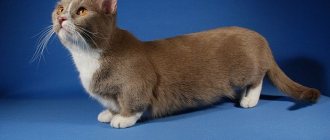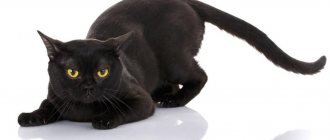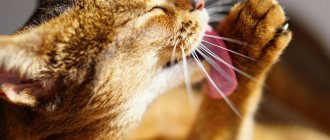Origin story
The serval is very similar in appearance to the cheetah, this is its main feature and unusualness. By and large, this is true. It seems as if he simply decided to temporarily accompany a wealthy owner and decorate a large mansion with himself.
The serval is native to Africa. The cat's valuable fur has always attracted the attention of poachers. Therefore, from year to year their numbers are rapidly declining, despite the initially impressive population size.
Today you can count more than 14 varieties of wild servals, differing in their color. Domestic servals began to appear when a certain group of people discovered that this type of animal was well tamed. Breeders began to take advantage of this, thereby obtaining incredible pets.
Types of purchase
Depending on the age, you can buy a serval:
- Two months old.
- Three months old.
- Four months old.
- Five months old.
The older the kitten, the more expensive it will be.
Depending on the place of purchase, the purchase can be:
- By advertisement in a newspaper or on the Internet.
- From a professional breeder.
- In the nursery.
The most expensive purchases will be from nurseries and breeders. You usually won’t find this breed at a pet market.
Description of the Serval breed
This proud representative of the African continent is a true predator. All these features are clearly manifested in his appearance. There are no specific unified breed standards, but some distinctive features are created by nature itself:
- They are characterized by a small head size and large, high-set ears relative to the entire body. They are colored with white and black stripes on the outside.
- The area of the bridge of the nose is quite wide.
- The eyes are almond-shaped along the lower edge, and their upper part resembles a boomerang.
- The head has long whiskers of a dense structure with pronounced pads.
- The total body length is small compared to other African animals. But relative to ordinary domestic cats, they are simply huge. The length from head to tail can reach 1 meter.
- The tail is from 25 to 40 cm.
- Servals have the longest limbs among all cats (relative to the rest of the body). Also, their hind legs are longer than their front legs.
- Weight can range from 8 to 18 kilograms.
- The color of the coat is very similar to the skin of a cheetah. The coat is covered with beautiful spots. They are located over the entire surface of the animal’s body, uniting on the back into long stripes. The muzzle, chest and belly are most often light in color. The overall tone of the fur varies from yellow-sand to brown-red. It is thick, tender and soft.
Origin and popularity
Servals were not immediately tamed and domesticated, and today these amazing creatures live in the wild. Egypt in particular, and a significant part of the African continent as a whole, can safely be considered their homeland.
In ancient Egypt, cats were always revered, but servals were very popular because of their hunting talents - where these bush cats appeared, snakes and rodents immediately disappeared. This is confirmed by many figurines and drawings with images of this cat found by archaeologists. Previously, they lived throughout Africa, and now they live mainly in the southern part of the continent (the largest number is in Tanzania).
The first mention of servals dates back to 1765. Then the famous Count Georges-Louis Leclerc described a large golden cat with distinct spots and stripes, which was a pet of the Royal Menagerie of Versailles.
The Serval breed got its name from the Portuguese name, but the nickname “bush” cat is due to its place of residence, since the animals try to hide in tall bushes. This helps to hide from larger predators and easily sneak up on prey.
If we talk about the domesticated serval, as it is known now, the breed was registered in the middle of the 19th century. They were owned exclusively by wealthy families throughout Europe, because they were a sign of high taste and even luxury.
It is difficult to distinguish wild animals from domestic ones by external signs; this is where habits come into play.
Temperament
Servals are primarily wild predators with their own character. In home conditions, you should carefully approach the issues of its manifestation. These beauties simply love to run and frolic, so do not interfere with this.
In nature, it is common for them to hunt birds. When jumping, they can reach a height of up to three meters. Therefore, you should be prepared for the fact that at home they will conquer all the heights available to them. Ensure that certain fragile or valuable items are kept away from areas where your pet is most likely to be.
This breed is generally quite friendly and curious. They explore their territory with great interest and protect it well. Many owners of these animals write that these cats are a little like dogs.
Health
At a young age, kittens should not be allowed to jump from high surfaces. Their limbs are very fragile during this period, so the risk of injury increases.
It is also necessary to monitor the animal's stool. If your pet experiences diarrhea more than twice a day, you should immediately contact your veterinarian. Cats of this breed require timely vaccination. IMPORTANT! Vaccinations must be done using inactivated drugs. Because the life of the animal depends on it!
Servals are also distinguished by the fact that they can mark their territory about 50 times a day. The process is accompanied by a very unpleasant odor. Therefore, the best solution in this case is castration. It is better to sterilize cats no older than one year, and cats should be subjected to the procedure as early as 8 months.
Life expectancy at home is higher than in the natural habitat. On average it is 15-20 years.
Appearance
Servals, like wild cats, are quite slender and flexible creatures with a length of 60 to 70 cm. They have a tail 40 cm long, a small neat head with an elongated muzzle, a clear chin and rounded ears.
They are distinguished from other cats by their legs, since they are the longest in relation to the body and the length of the body. The ears are also the largest compared to other breeds. The weight of males is from 9 to 18 kg, in females from 9 to 13 kg. They are very similar to cheetahs, but have a shorter tail.
If we compare the serval with the caracal, the former are 30 cm taller and do not have the characteristic tufts of hair on the ears, while they also exceed in height the South American ocelots.
Servals have dense short hair and undercoat, so they do not shed much and are not difficult to care for. Cats have one color and it is their calling card. The basis of the color palette is sand-copper color with dark brown inclusions in the form of spots and oblong stripes. The belly is distinguished by a predominantly white or light beige coat.
It is noteworthy that in nature there are no servals with a single characteristic pattern of spots and stripes - the coat of each individual is unique. The inclusions differ in size and location, color intensity and shape. In forest animals they will be less noticeable than in those whose habitat is meadows. At the beginning of the 19th century there was even a theory that forest and meadow cats were different species.
This is also due to the fact that even completely black servals live in Kenya. There are also snow-white cats of this breed, but they have already been created artificially through selection.
Dark stripes begin at the base of the head, pass between the ears and run along the back, after which in the area of the shoulders they smoothly diverge into four lines, which continue numerous spots.
In addition to spots, the serval has dark rings on its tail, and the tip is colored black. It is fluffier than the main part of the body. They can also be recognized by the back of the ears, which has a black tint to the fur and a white line. The ears are set close together, which allows predators to clearly hear all sounds with amazing accuracy. It helps in hunting and survival in the wild.
Bush cats have a boomerang-shaped upper eyelid and green eyes, only in rare cases they are a different shade.
A distinctive feature of the breed is its beautiful slender body. Thanks to this and their long legs, servals manage to gain significant speed in pursuit of prey.
Care and maintenance
Raising a safe animal with a kind and easy-going character at home is possible, but you should follow a number of rules:
- The kitten should be hand fed. This way he will form pleasant associations with the owner, he will feel safe
- All play with a baby serval should be done on the floor. This will prevent him from seeing you as a threat.
Expert advice:
- Avoid playing with the owners' hands and feet.
- Don't raise your voice at your pet. The Serval responds well to voice commands. It is strictly forbidden to beat an animal; servals do not forgive this.
- The best punishment for bad behavior is being left alone. The animal is aware of its behavior and will definitely come to peace.
- It is easy to teach a kitten to the “no” command using a simple spray bottle, sprinkling water on it if the baby does something forbidden.
Approximate prices
In Russia you can buy a Serval kitten for approximately the following price:
- According to an advertisement submitted on the Internet - from 450,000 rubles .
- In a nursery, from a professional breeder - from 500,000 rubles .
A purebred kitten with a pedigree and all the necessary documents costs about 1,600,000 rubles . A hybrid brood is sold at a price of 630,000 rubles . If the animal costs less than 400,000 rubles, then it is better not to take it: most likely the seller is passing off another, less valuable breed as a serval.
Where to buy a Serval kitten?
We were one of the first in Russia to start working with Servals brought from the USA, Canada, and the Czech Republic.
The recommended age for purchasing a pet of this breed is from 1.5 to 5 months. The younger the kitten is, the higher the likelihood of growing him into a loyal and devoted friend.
It is best to purchase an animal from a nursery where you can see its parents, from professional breeders with good recommendations.
On average, the cost of a kitten is 450-550 thousand rubles. You can find it cheaper, but there is no guarantee that you will get a socially adapted animal, and in the future it will turn out to be a well-mannered pet.
This is a very rare exotic cat not only in Russia, but throughout the world. Features of appearance, as well as nuances of maintenance, make servals cats of the highest segment.
Keeping a Serval at home is not a cheap pleasure. Such an acquisition will emphasize the high status and financial position of its owner.
Features of character and behavior
In character and habits, the serval is more reminiscent of dogs. This is explained by their tendency to be devoted and attached to their owners, although it will take much more time to establish contact with the animal than if it were an ordinary cat. The pet will always be faithful to its owners and will defend itself in any unpleasant situation. If you hand feed him from childhood, it will be much easier for the hunter to establish contact with his family.
Servals are agile, playful and active creatures that require a lot of attention. They are highly trainable and owners of wild cats need to train them in order to tame their proud nature. You need to be accustomed to a leash and collar from childhood.
Animals will be more comfortable living in a private home, where they can easily spend time in the fresh air, develop breakneck speed and splash out energy. You can have them in an apartment, but you will have to take care of walking the cat and active games.
You need to understand that the animal has powerful teeth, so games are played exclusively with balls, sticks and special toys. It is important not to play with the cat with your hand or foot, because even a weak bite from a serval leaves serious injuries for a person, and especially a child. Typically, breeders recommend that owners acquire a whole arsenal of toys.
The bush cat easily finds a common language with other pets and becomes a family favorite. You should be wary of keeping this breed together with rodents, birds and snakes, as they can become common prey. Hunting instincts are well manifested even in domesticated animals.
It is undesirable to follow your pet - he will perceive such behavior as danger. It is better to attract his attention with his favorite treats, entertaining toys and conversation. It’s easier and more interesting for him to come to the owner himself.
The Serval feels great discomfort and distrust of strangers. When visiting guests, a cat may find a secluded place and sit there until the strangers leave the apartment. It would be a terrible mistake to show off an unusual cat to guests. This causes great discomfort for the pet and can even cause psychological trauma, as well as negatively affect the relationship with the owner. Trust will be undermined.
Servals are extremely intelligent creatures, but they often awaken wild instincts when in danger. When playing with children, it is necessary to carefully monitor the behavior of the children. If they offend the animal, it may give an answer, or the cat will develop a fear of children and over time it will no longer be possible to overcome this problem. In this case, the serval will react aggressively to babies, and he will easily distinguish the child by his voice.
It is important to give the cat the opportunity to retire and be alone in a comfortable and convenient place that belongs only to him.
When meeting other pets, the predator is cautious. He needs time to create a harmonious and trusting relationship - you shouldn’t force him. Particular attention is necessary when a pet interacts with small animals, because it has great strength and sometimes can cause harm even without malicious intent.
Bush cat does not equal danger
Those who want to own this breed, in most cases, are shrouded in many doubts and fears. Servals, despite long attempts at selection and years of taming, have the characteristic features and habits of a wild animal. Before getting such an animal, you should be well acquainted with the characteristics of its character.
As the experience of many breeders and owners of domestic servals shows, doubts are in vain if you understand how to properly handle such pets and purchase them from trusted nurseries.
Domesticated kittens are very devoted to their owner, showing insane affection and love every day. Even in the wild, a cat is unlikely to be interested in a person - it hunts birds and rodents. In case of danger, it will not attack a person (exceptions may be cases of human aggression towards a cat’s offspring), but in defense it will begin to hiss or simply run away.
As for the interaction of an individual with children, raising children is important here. There is no need to allow attempts to pull a tail or six, loud screaming and squealing, blows and chases. With respect and care, the serval will develop a strong friendship with the child and he will become a fierce defender of his little owner.
When choosing a pet, you need to take into account the kitten's behavior. He must be adapted to communicating with people, and not rush at the first opportunity. It is better to buy small kittens from 1.5 to 2 months. They quickly get used to their owners.
Serval content
Caring for a pet of this breed cannot be called difficult. To keep him healthy and happy, it is enough to follow the following recommendations:
- Sleeping area.
Servals like to watch what is happening from a height, so they may choose a high cabinet or shelf. To exclude such a moment, it is important to provide him with a personal house at a height. - It is important to contact a veterinarian in time to castrate or sterilize your pet, since otherwise he will behave aggressively and mark corners;
- It is better to remove breakable objects in an apartment or house from visible and elevated places, because the animal does not always calculate its speed;
- It is not difficult to train a Serval to use a litter tray. Even if he makes mistakes, you need to verbally explain to the cat what is wrong and point to the right place. Over time, she will understand where the toilet is;
- This breed requires a special approach in terms of nutrition
. The cat should be fed high-quality raw meat from 800 g to 1,300 kg (rabbit, beef, lamb, chicken, turkey, tuna, salmon, mackerel), feed mice, raw eggs. Cheese, tomatoes, cherries, oranges and bananas are used as delicacies. Vitamin complexes with a high calcium content are also required; pork is prohibited. For an adult cat, once a day is enough, but it would not be a bad idea to carry out fasting days once every couple of weeks. For kittens, the meat is ground into mince. If you feed dry food, then it should be from premium producers; - The serval must be provided with clean drinking water. Representatives of the breed consume large quantities of water;
- Requires vaccination
. Vaccines are used without active viruses; - Diarrhea (more than 2 similar stools) requires a visit to the vet, as does any unusual behavior;
- Up to 6 months, it is important to prevent the cat from jumping from heights, since the bones have not yet become stronger;
- Some animals may require declawing. There is a lot of controversy regarding this point; it is better to discuss this topic with a specialist;
Pros and cons of the breed
Many fans of exotic cats dream of a serval, but before buying it is worth assessing your capabilities. These cats, like representatives of other species, have both advantages and disadvantages.
On the plus side
it is worth noting:
- Unusual appearance;
- Devotion and loyalty to family;
- Curiosity and openness;
- Tendency to train;
- Easy care;
- Possibility of living together with other animals;
- Dog habits and strength.
Flaws
the serval has, although much less. This:
- Expensive maintenance;
- Aggression in response to shouting, attacks and inappropriate behavior of children;
- Difficulties in breeding;
- Tendency to speed runs and jump indoors;
- Stubbornness;
- During sexual activity they mark their territory.
Pricing policy and important nuances when purchasing.
Prices for Serval kittens start at $1,200 and can reach up to $8,000, depending on the manifestation of the main characteristics of the breed.
This is due to difficulties in breeding (wild cats practically do not reproduce in captivity) and expensive maintenance (it is better to buy a kitten at 10-12 weeks with the appropriate documents and vaccinations). It is important to understand that keeping such a kitten will have a significant impact on the budget and you won’t be able to save on an exotic cat.
Servals rightfully top the lists of the most interesting and popular cat breeds around the world. They are graceful, but at the same time incredibly strong, beautiful and loyal. Such a pet will delight you with affection for 19-20 years with proper care and attention. The serval's trust must be earned, but he will provide protection and love to his owners throughout his life.
Five reasons to buy a kitten in our nursery
1. We almost always have kittens in stock that you can purchase;
2. Since they are all born in our nursery, we can offer lower prices;
3. If you wish, you can order a kitten for yourself from different manufacturers, having previously visited our nursery;
4. We keep grown cats of all breeds so that you can see what your pets will become in the future;
5. We do not try to deceive customers for the sake of sales at any cost.
Buy a Serval kitten
What does the price depend on?
In Russia, a serval can be bought for varying amounts of money. The price is formed under the influence of a number of factors:
- Age of the kitten.
- Purebred.
- Place of purchase.
- Availability of pedigree.
- Coat color, intensity.
- State of health.
- Generation.
- Availability of a veterinary passport.
- Availability of a veterinary card.
Hybrids between a serval and a domestic cat are called Savannahs and are much cheaper than purebreds. Having a veterinary card or passport makes the purchase more expensive. The more intense the color of the animal, the higher its cost will be.











